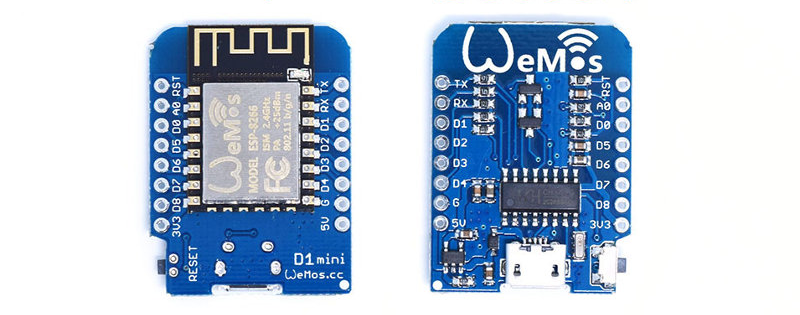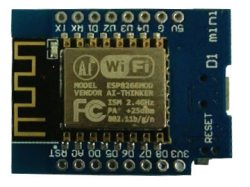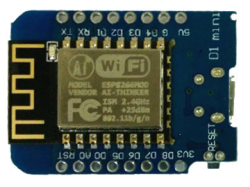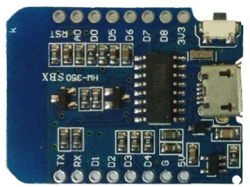ESP8266-based development boards have proliferated rapidly. One favorite, the WEMOS Mini-D1 is frequently imitated and sold without any branding. As these boards continue to ship to hobbyists and retailers around the world, we thought it might be interesting to conduct a little experiment.
There are a few ESP8266 development boards available, and the most popular seem to be the NodeMCU ‘Amica’ board. Of course, there are dozens of other alternatives including the WiFiMCU, Sparkfun’s ESP8266 Thing, and Adafruit’s HUZZAH ESP8266. Given that, why is this review limited to the Mini D1 boards? Because the Mini D1 is the cheapest. Or was, until it was cloned.
We took a look at some of these ‘clone’ boards to figure out the differences, find out if they work as intended, and perhaps most importantly, are these clone boards shipped out reliably. What are the results? Check that out below.
Like the NodeMCU, the Mini D1 is also ubiquitous and has already been picked up by cloners. The D1 is smaller and slightly cheaper. The pin headers are provided separately if you don’t want them attached. It’s practically the same dimensions as this motor controller, this type of battery, and this charging circuit for some really tiny swarm-ready robots. It also shines when you need many MQTT nodes, or to upgrade an RC car. In short, it’s tiny, it’s cheap, and it’s still a great board that we expect interesting projects to use for some time.
Methods
We ordered 28 Mini D1 clones split among the two most common designs on Taobao. Taobao is a staggeringly large Chinese online marketplace that mainly targets the local market. Caveat emptor.
We tried two different import companies that manage orders from Taobao. The parts were split so that each company had to manage multiple suppliers, and the parts were shipped to a neighboring country for testing. This type of import company is common in some Asian countries and typically adds something like a 20% surcharge to manage your order.
Comparison
Electrically, the clones reviewed were identical to the original WEMOS board. All components were the same across boards, and the soldering job was good. Some boards used SMT resistors with EIA-96 markings, others with the more familiar 3-digit code:

However, there are some very slight differences in board layout. Board 1 had square corners rather than rounded, slightly thicker traces in some places with a few routing differences, better pads overall, fewer soldered mounting points on the USB mini connector, large clear labels for all pins, and no exposed pads for the reset switch.
Board 2 had thinner traces, thinner pads around all vias, a properly secured USB mini connector, and exposed pads for the reset switch. The labeling for all pins was in a tiny font. Due to the thinner pads, soldering was slightly more challenging, and it was noted that when soldering at 480 °C (we’re all in a hurry sometimes) there was some superficial heat damage to the PCB – this was not observed on Board 1.
Results
In summary, both boards are essentially identical, with perhaps a slight advantage to Board 1 for solderability, and to Board 2 for better access to the reset switch and a more securely fastened USB port.
Looking back to the actual WEMOS Mini D1 board, it has a properly secured USB port, and nice pads around all relevant vias. There seems to be an effort to revise and improve the board as time goes on. The clones are barely cheaper even in bulk. We’d say that an actual WEMOS board is likely the best value for money.
This brings us to another point: on their website, WEMOS provides a tool to verify if a product is genuine using the ESP8266 chipID. Unfortunately, it doesn’t seem to work presently.
All imitation boards properly registered as serial devices in both Linux and Windows and worked correctly with both NodeMCU and Arduino firmware. All reset switches worked. This was actually a bit surprising – a failure rate of about 5% was expected based on previous orders of similar parts. We may have just gotten lucky.
Summary
The cloned WEMOS Mini D1 boards do what they’re supposed to do. While the build quality is quite tolerable, there are some minor flaws. Ordered from the manufacturer, cloned boards are not much cheaper than the original, on the order of $1 per board, and ordering them was not a very streamlined process.
We also ordered 40 NodeMCU ‘Amica’ boards from Taobao. Overall it was the same experience, except that two boards were dead on arrival. One was beyond recovery, and the other had a defective reset switch that was swiftly replaced.
The worst experience surrounding these boards was actually ordering them. Everything arrived — eventually. Some parts in a week, others in a month. There’s no order tracking. No one in either company knew where any of the parcels were. One person told us every day for a week they would arrive ‘tomorrow’. Basically, you pay in advance, then hope things arrive by your deadline. Still, for bulk orders with no deadline these shortcomings are arguably tolerable.
For most of our readers, we cannot recommend the experience, especially in a world with Adafruit, Sparkfun, and the Hackaday Store. If you live in or near mainland China though, Taobao often lives up to its name.
Have you used similar boards to good effect? Or did they go up in flames? Tell us your story in the comments.




















Great article! I’m going to make a worklog about volatility of Chinese breakouts/devboards soon, on ZeroPhone project page. ZeroPhone relies on Chinese breakouts (for its current version, at least), and those boards appear to be actually prone to layout and pinout changes – I’d guess that, as the designs get picked up by different fabs (maybe by re-tracing the PCB along the way), they also get optimized and different decisions are made each time.
tl;dr- I ordered 25pcs SPI 1.3″ OLED screen breakouts, which are identical to breakouts I previously bought, with one small change – they have RST pins instead of CS. It basically makes them unable to share the SPI bus with some other device, frankly, some kind of braindead decision. This change can be fixed by using Xacto knife and a solder blob (RST and CS pins are next to each other on the OLED FPC), but I shouldn’t need to do that, nobody should.
For example, I use Arduino Pro Minis a lot, and each time they manage to cram more and more pins onto it – the Pro Minis I received from TaoBao recently have A4-A7 AND a 6-pin ISP header! The ISP header basically duplicates VCC/GND/D11-D13/RST, and the board seems to have lost a decoupling capacitor, but it works. I’d say I have about 10 different Pro Mini board examples, and in the upcoming article I’ll have photos, too – so stay tuned =)
Also, how the hell did you get 1$ per board? Asking for a lower price?
Or is it “1$ cheaper”?
It came out around 1$ USD cheaper per unit. I came to this value by looking at the cost of each module including management fees but not shipping, and compared to the price of WEMOS modules from the actual manufacturer on Aliexpress.
Not a perfect comparison I admit, and the price difference fluctuates. I suppose the takeaway message is that the differential is not as big as you might expect.
On the other hand, the street price of WEMOS clones in my corner of Asia is about 50% higher than the cost of ordering direct from Taobao. Only clones are available locally.
In fact I originally found out WEMOS existed when saw the cloned modules at the local market, was impressed by the design, and got curious about who made them. Probably not an effective marketing strategy though :)
I really dont know what i expected…. I was thinking on sending this to Stop Clickbait, but then i thought… They live in the united states of america… They dont know what it is to order something from sparkfun, adafruit or hackaday store in europe, and i am guessing in the rest of the world.
So in summary… yes, it is worth to order something in china, if you live in europe, because, first: The send price of anything from america is at least 18$ (and dont forget customs), second: The send time from america and china is almost equal. And third, people dont care about quality. If something doesnt work from china, the seller will send you another board, chip or whatever you buyed, or (in the most cases) give you the money back. If you want something fast, then we might probably go to amazon.
Anyway… in my opinion, china quality is aceptable, and orders arrive as fast as USA orders do, and everything costs 1/8 of the price you can get electronics here in europe…
+1 fully agree and don’t forget that most items from china will have free delivery worldwide no matter how much they cost and mostly they cheat on the customs sheet so an item that costs like 60$ most often gets declared as 10-20$ items don’t know if this is on purpose or they just suck at math but in any case my experience is that customs rarely bother to open parcels with such a low value.
They do it on purpose, under 20$ (if i recall correctly) it’s considered as a gift. Customs don’t open it and you don’t have to pay the fee!
It’s due to European customs regulations. If you stay under €22 excluding shipping, there will not be a customs procedure nor taxes. It’s just not worth the hassle.
The same goes for gifts send from a consumer to a consumer. That’s the ‘old’ trick Chinese used, but most countries don’t fall for that one anymore.
Not only Europe, but here in the other Americas also. People buy from China because its cheap. I also buy from China/AliXpress/Taobao/DX because most times , even if the price of the item is reasonable, the shipping costs are not. So the option is buy from China most of the times, or find a friend going to the US or UK to pick up some items from Farnell / Digikey .
+1 I can’t agree more. Being in the other Americas, buying from china is much, much, much cheaper than buying from North America (Ada,Spark,Digi,Eby,Ama) . Yes it took around 4 to 6 weeks, but for $0 shipping cost, is unbeatable. Usually good chinese sellers send you replacement units or refund money, in case of damages without much asking. No need to mail return bad items!
My entire experience with Maker Shed is “Oh hey, this is only a couple bucks more than the Chinese clone, I want this thing for $20!” Load cart. Shipping is $15. Leave and buy it from China.
Especially infuriating when I know my whole order would fit in a $7 flat rate USPS box.
very common sentiment. Often you are willing to pay the premium for the device to come Locally only to find shipping is more then the devices ordered… not unlike the so called $5 RPI zeros that have another $5 in postage
That’s a fair point. I’m sure there are a few of us here with global perspectives on parts sourcing. I’m happy to share mine.
During my time in North America, I used deal extreme, or Chinese eBay retailers extensively for hobby projects and was generally pleased with their service. Digikey was way better when I was on a deadline though. Basically the same strategy there as in Europe, but with a longer shipping time from China playing a role.
After moving to Southeast Asia, it actually became much more difficult to order things from China, and Digikey was out of the question. So you either make do with what’s at the local market (assuming you can communicate), or deal with a variable lead time of 2-8 weeks ordering from China, and the price is only about 33% less.
I can tell you that clients do not like to hear that you’re going to start their project in such a variable time! It also makes it harder to do things like organize workshops at local hacker/maker spaces. The best solution I’ve found is to keep my own inventory, but the opportunity cost in time and money is not negligible.
It’s getting better in SE Asia with online retailers like Lazada starting to play a local role similar to Amazon, but it still presents a challenge when a significant minority of my work is rapid prototyping. If there were a service like Digikey, something with a higher price point but reliable, fast delivery — I would pass the extra cost onto clients and everyone would go home happier at the end of the day.
I’m curious what the process is like in other parts of the world!
We have lead times of months for workshops, plan them long before they happen and just wait for the parts with checklist for every workshop when all parts have arrived we set a fixed date for the workshop. Ordering from the usual chinese sites.
Works ok because of long time volunteer engagement.
Well, as i already said we wont use adafruit or sparkfun, or even oshpark (yeah, i like their purple color boards, but i wont pay the price for shipping… It is just crazy) If i need something fast, as i will first search it amazon, then in ebqy, and at last in rs components. Sometimes things are also so expensive in china, or you can buy them just in bags of 50,100, 200, that they are not worth to buy them there, so i go to rs components. Yesterday i was searching for de lt3652, and the pakage i needed is in bags of 50. The prize of the chip is 5€/chip, so it wasnt, very realible. In the end i bought in rs components, where everything was cheaper, and still the chips where 10€ each if i wanted 3
And what about WeMos D1 R3 board available on aliexpress and ebay in last time?
I can’t found any site with info about them.
Hmm, I don’t see any of those USB mini ports like it says in the post ;)
And how about the new “WEMS” ESP32 board with built-in OLED? It isn’t a clone of anything WEMOS sells but still has their logo on it:
https://www.reddit.com/r/esp8266/comments/66u7jt/wemos_now_selling_esp32_board/dglx4l4/
I don’t understand why they’d go to the trouble of creating something new and useful like this and then not just make it be their own brand – WEMOS isn’t *that* well known yet.
It’s a clone of this: https://www.tindie.com/products/lspoplove/d-duino-32esp32-and-096oled-display/
“cloned boards are not much cheaper than the original”
This is the Wemos D1 Mini on Aliexpress $5.49(AUD)
https://www.aliexpress.com/store/product/D1-mini-Mini-NodeMcu-4M-bytes-Lua-WIFI-Internet-of-Things-development-board-based-ESP8266/1331105_32529101036.html?spm=2114.12010612.0.0.rYWbSd
This is the Clone for $3.91(AUD)
https://www.aliexpress.com/item/ESP8266-NodeMcu-Lua-WIFI-board-D1-mini-version/32727167467.html?spm=2114.13010308.0.0.wMW0nB
Wemos takes a MONTH for delivery, whilst the clone re-seller does DHL shipping(if you choose to pay more)
Recently ordered some boards from the “official” Wemos Aliexpress store, got my stuff in under 2 weeks (to the Netherlands). DHL shipping is usually horiffically expensive and not actually all that much faster.
So.. no one going to comment about the elephant in the room? Ok. I will.
Who in their right mind solders small components at 480C?
+1 I’m pretty confused on how that would make the job faster.
Yep, any flux within the solder wire becomes useless instantly.
But the BIG thing to ask is how does the PCB antenna perform! Cloned PCBs often copy only the “picture” of the antenna and the tunning goes straight down the drain. Also the PCB specs must be controlled, impedance matched, etc. A properly working PCB antenna is not and easy feat!
That’s an interesting question, I hadn’t thought about that!
I have noticed that the PCB board material varies slightly between clones (you can sort of see in the photos), so there could be an effect here!
There is no antenna on the WEMOS (or clone WEMOS) board. They all use the ESP8266 modules…
The PCB-antenna is on the ESP8266-module which is bought as a ready-made part. it should be the same for all clones.
RobotDyn sell some top notch clone
they even include u.FL/IPX slot with a defined line.
so you wont need to solder or move 0 resistor thing
So where is the performance comparison?
I bought both the “original” and clones of the D1 Mini on AliExpress (the clone were priced as 10 for 25$ in 08/2016).
The clone has a slightly different layout on the bottom side and I can’t connect to them via USB some times (like 5% of the time). The clones have the 4M SPI and seem to be reliable as far as I’m concerned once programmed. There were shipped in separate anti-static zip-locs, with the additionnals headers in a separate bag.I just checked and you can still find similarly priced bags, but I was unable to find a similar board layout.
One good thing with about the Ali wemos store ( http://s.click.aliexpress.com/e/FmynYRF ) is that all the shields and accessories are near and easy to browse, with the clones you have to surf between diferent sellers.
Sadly, here in the future of July 2021, my success rate with random Wemos D1 Mini boards has been much more varied. A fair number show up in Arduino ready to program (serial is found), but give various errors and timeouts when attempting to program. I’ve tried all kinds of variations to reflash them, grounding D3 or D8 or applying an external 5v power supply, all to no avail. Also different USB cables. Comes down to some work, and some don’t. And it’s unclear on say Amazon which boards are which.
This is for the original “silver box” esp 8266 module versions. I’ve had more consistent success with various “V3” orders & clones, but I think I’ll stick to authentic WEMOS/LOLIN product from now on.
(I also switch to OTA programming after first flash, as it’s more reliable than serial, when possible. Until my code is bad again and I have to USB it again.)
Sadly I’m running into the same issues, my first board preformed well had my code working and flashing OTA, then started resetting with the same code, wouldn’t respond OTA, went into endless reboot when reloaded with the basic ota sketch loaded over usb. stripped the OTA out of the sketch, resets when input button is pressed. board goes in the trash.
I’m ordering some of the V4.0 LOLIN D1 minis from the wemos site. the clones are not worth the headache.